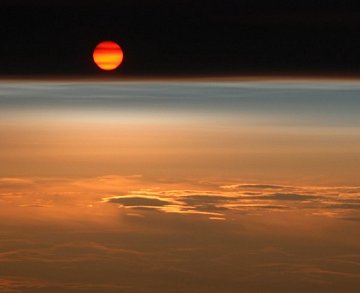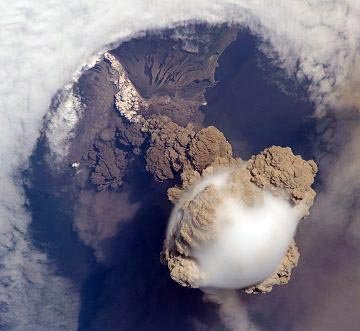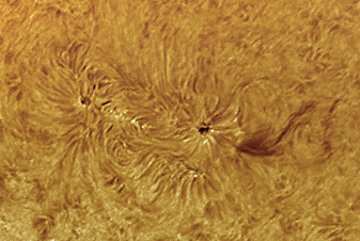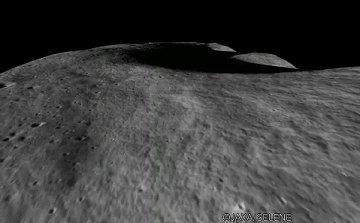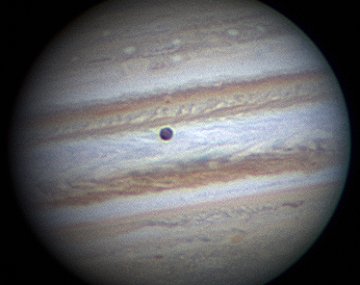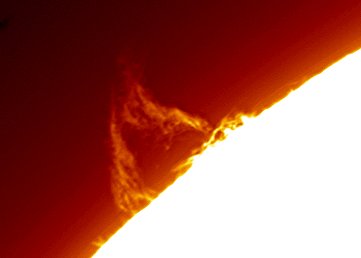On February 2, 2009, there were 1019 potentially hazardous asteroids.
On April 1st, there were 1049 potentially hazardous asteroids.
On April 8th, there were 1050 potentially hazardous asteroids.
On May 3, there were 1054 potentially hazardous asteroids.
On June 2, there were 1061 potentially hazardous asteroids
On June 26, there are 1065 potentially hazardous asteroids
| Asteroid |
Date(UT)
|
Miss Distance
|
Mag.
|
Size
|
| 2009 KR21 |
June 1
|
0.7 LD
|
16
|
21 m
|
| 2009 KL8 |
June 1
|
5.1 LD
|
18
|
63 m
|
| 2003 QO104 |
June 9
|
36.8 LD
|
14
|
2.9 km
|
| 1994 CC |
June 10
|
6.6 LD
|
13
|
1.2 km
|
| 2001 FE90 |
June 28
|
7.0 LD
|
13
|
435 m
|
| 2002 KL6 |
June 28
|
57.5 LD
|
16
|
1.4 km
|
| 2006 MV1 |
June 30
|
9.6 LD
|
23
|
20 m
|
1 LD also equals 0.00256 AU. MAG is the visual magnitude of the asteroid on the date of closest approach.
CURRENT SOLAR FLARE DATA
CURRENT SPACE WEATHER DATA
CURRENT SOLAR X-RAY DATA
LASCO IMAGES
NEBULA - THE RIGHT HAND OF APOLLO
TOWARD THE END OF TIME
IT'S THE DANGER OF THE SUN
| 6-30-09 - New sunspot coming around the left lower corner
NEW SUNSPOT:
Observers are reporting a new sunspot forming near the
sun's southeastern limb. Current conditions Solar wind speed: 453.7 km/sec density: 2.7 protons/cm3 explanation | more data Updated: Today at 2347 UT X-ray Solar Flares 6-hr max: A0 1810 UT Jun30 24-hr: A0 1810 UT Jun30 explanation | more data Updated: Today at: 2340 UT
|
||||
| 6-29-09 - No sunspots today
Current conditions
Solar wind speed: 518.8 km/sec density: 1.5 protons/cm3 explanation | more data Updated: Today at 2346 UT X-ray Solar Flares 6-hr max: A0 2340 UT Jun29 24-hr: A0 2340 UT Jun29 explanation | more data Updated: Today at: 2340 UT SOLAR WIND: A solar wind stream is buffeting Earth's magnetic field, but it is not stirring up geomagnetic storms or auroras. Geomagnetic activity should remain low.
|
||||
| 6-28-09 - No sunspots stoday
Current conditions
Solar wind speed: 418.4 km/sec density: 9.0 protons/cm3 explanation | more data Updated: Today at 2325 UT X-ray Solar Flares 6-hr max: A0 2340 UT Jun28 24-hr: A0 0400 UT Jun28 explanation | more data Updated: Today at: 2340 UT
|
||||
| 6-27-09 - The sun is blank today
Current conditions
Solar wind speed: 399.6 km/sec density: 2.7 protons/cm3 explanation | more data Updated: Today at 2346 UT X-ray Solar Flares 6-hr max: A0 2340 UT Jun27 24-hr: A0 2340 UT Jun27 explanation | more data Updated: Today at: 2340 UT
|
||||
| 6-26-09 - No sunspots today Current conditions Solar wind speed: 402.8 km/sec density: 3.1 protons/cm3 explanation | more data Updated: Today at 2156 UT X-ray Solar Flares 6-hr max: A0 1725 UT Jun26 24-hr: A0 1725 UT Jun26 explanation | more data Updated: Today at: 2145 UT
Earth is inside a solar wind
VOLCANIC SUNSET: On June 22nd, photographer Brian Whittaker was flying 35,000 feet above Nunavut, Canada, when he witnessed "the most spectacular sunset that I have ever seen," he says. "The giant volcanic cloud from Russia's Sarychev Peak [see below] was illuminated by the arctic sun--and this completely transformed the landscape. For a moment, I thought I was on Mars." This was the view from the window seat: "All the curtains were drawn so that people could sleep which is very normal," notes Whittaker. "It is possible that very few people have seen this despite all the potential observers!" Whittaker's airplane traveled all the way from British Columbia to Europe, so he got a good long look at the cloud. "It stretched for more than 4,000 kilometers. Will it reach Europe?" he wonders. Stay tuned for updates. SARYCHEV PEAK VOLCANO: Perfect timing. On June 12th, just as Russia's Sarychev Peak volcano was erupting for the first time in 20 years, the International Space Station flew directly overhead. Astronauts had their camera ready and snapped one of the most dramatic Earth-science photos ever taken from space: Researchers are studying this rare photo to learn about the early stages of powerful volcanic eruptions. A few phenomena stand out: (1) The volcano erupted with such force, the plume actually punched through the atmosphere. Note how clouds around the volcano have parted in a circular ring--that is a result of a shock wave produced by the upward blast. (2) The plume is a mixture of brown ash and white steam. A "dirty thunderstorm" complete with lightning could be in progress within the roiling cloud. (3) The smooth white bubble on top of the plume is probably a mass of water condensing from air shoved upward by the rising ash column. If so, it is akin to the iridescent pileus clouds sometimes featured on spaceweather.com. If you're not amazed yet, try this: Put on a pair of red-blue stereo glasses and behold the eruption in 3D. The anaglyph was created by graphic artist Patrick Vantuyne of Belgium. No stereo glasses? A cross-eyed version is also available.
|
||||
| 6-25-09 - Sunspot 1023 is fading
Current conditions
Solar wind speed: 472.8 km/sec density: 3.1 protons/cm3 explanation | more data Updated: Today at 2346 UT X-ray Solar Flares 6-hr max: A0 2340 UT Jun25 24-hr: A0 2340 UT Jun25 explanation | more data Updated: Today at: 2340 UT GEOMAGNETIC STORM: A solar wind stream hit Earth's magnetic field on June 24th, sparking a brief but potent geomagnetic storm (Kp=5). The midnight sun prevented sightings of Northern Lights around the Arctic Circle.
|
||||
| 6-24-09 - Only sunspot 1023 remains
of new Solar Cycle 24. Credit: SOHO/MDI SUNSPOT SYZYGY: Sunspot group 1023 has an eye-catching shape--it is a straight line. The group's four spots have formed a rare "sunspot syzygy." The formation makes a nice target for backyard solar telescopes. more images: from Andy Dodson of Huirangi, New Zealand; from Pavol Rapavy of Observatory Rimavska Sobota, Slovakia; from Steve Wainwright of Swansea South Wales, UK; Current conditions Solar windspeed: 479.4 km/sec density: 4.7 protons/cm3 explanation | more data Updated: Today at 2345 UT X-ray Solar Flares 6-hr max: A0 2340 UT Jun24 24-hr: A0 2340 UT Jun24 explanation | more data Updated: Today at: 2340 UT
|
||||
| 6-23-09 - Two sunspots today - 1022 and 1023
Sunspot 1022 is rapidly fading away. Both 1022 and 1023 are members of Solar Cycle 24. Credit: SOHO/MDI SUNSPOT WATCH: Yesterday, in a moment of rare extravagance, the sun produced two spots. Today, one of them, sunspot 1022, is fading away. The other, sunspot 1023, is still going strong:Amateur astronomer Jacob Bassøe took the picture hours ago from his backyard observatory in Copenhagen, Denmark. "It is a nice bipolar sunspot with a bushy dark filament emerging from one of the cores," he says. The magnetic polarity of sunspot 1023 identifies it as a member of new Solar Cycle 24. Its appearance coincides with the movement of two solar jet streams into a range of heliographic latitudes that promotes sunspot formation. No one knows exactly how the sun's deep jet streams boost the sunspot count, but they do. As a result, this week's sunspot activity might herald more to come. Stay tuned for updates. more images: from Pete Lawrence of Selsey, West Sussex, UK; from Didier Favre of Brétigny-sur-orge, France; from Michael Buxton of Ocean Beach, California; from Peter Paice of Belfast, Northern Ireland Current conditions Solar windspeed: 260.5 km/sec density: 8.2 protons/cm3 explanation | more data Updated: Today at 2347 UT X-ray Solar Flares 6-hr max: A0 1840 UT Jun23 24-hr: A0 1840 UT Jun23 explanation | more data Updated: Today at: 2340 UT
|
||||
| 6-22-09 - Sunspot #12
in the sun's southern hemisphere. | Both are members of Solar Cycle 24. Credit: SOHO/MDI NEW SUNSPOTS: Since 2007, it has been unusual to see even a single spot on the sun. Today there are two. Jacob Bassøe photographed them this morning from his backyard observatory in Copenhagen, Denmark: The magnetic polarity of the two spots .htm"> solar jet streams into a range of heliographic latitudes that promotes sunspot formation. No one knows exactly how the sun's deep jet streams boost the sunspot count, but they do. As a result, these tiny spots might herald more to come. Stay tuned for updates. more images:
from Pete Lawrence of Selsey, West Sussex, UK;
from Didier Favre of Brétigny-sur-orge, France;
from Michael Buxton of Ocean Beach, California speed: 280.0 km/sec density: 3.0 protons/cm3 explanation | more data Updated: Today at 2345 UT X-ray Solar Flares 6-hr max: A0 2340 UT Jun22 24-hr: A5 0835 UT Jun22 explanation | more data Updated: Today at: 2340 UT
A solar wind stream flowing Space Weather News for June 22, 2009 |
||||
| 6-21-09 - No sunspots today
Current conditions
Solar wind speed: 304.5 km/sec density: 4.6 protons/cm3 explanation | more data Updated: Today at 2345 UT X-ray Solar Flares 6-hr max: A0 2120 UT Jun21 24-hr: A0 2120 UT Jun21 explanation | more data Updated: Today at: 2340 UT HAPPY SOLSTICE: Summer begins in the northern hemisphere on Sunday, June 21st, at 5:45 am UT (1:45 am EDT) when the sun reaches its maximum declination above the celestial equator. At the same moment, winter begins in the southern hemisphere. Happy Solstice!
|
||||
| 6-20-09 - No sunspots today
A solar wind stream flowing speed: 363.8 km/sec density: 9.6 protons/cm3 explanation | more data Updated: Today at 2347 UT X-ray Solar Flares 6-hr max: A0 2340 UT Jun20 24-hr: A0 2340 UT Jun20 explanation | more data Updated: Today at: 2340 UT LAST SHOTS FROM KAGUYA: On June 10th at 1825 UT, Japan's massive Kaguya spacecraft crashed into the Moon. The Japanese space agency, JAXA, has just released a movie of Kaguya's last moments. Click on the image to set the scene in motion: The onrushing landscape is what Kaguya's cameras saw as the spacecraft glided into the lunar surface at a shallow angle. When the 2,900 kg spacecraft hit the surface at 6,000 km/hr, astronomers in Australia observed a fireball at the impact site. The explosion punctuated a remarkably successful mission of lunar discovery. Why bother hitting the Moon? For one thing, it's a good way to end a mission. Lunar satellites can't orbit forever because the Moon's gravitational field is weird and lumpy. Crashing is better than flying off into space, where the spacecraft could pose a hazard to other missions. Crashing also produces a fireball, which allows astronomers to estimate the "luminous efficiency" of objects hitting the Moon. Luminous efficiency is a key parameter required to interpret genuine lunar meteorite impacts. Also, hitting the Moon might uncover something interesting--like evidence of water. NASA's LCROSS spacecraft will attempt that trick later this year. GREAT GANYMEDE: On June 16th, Paul Haese of Blackwood, South Australia, looked at Jupiter through his 14-inch Celestron telescope and witnessed a "dark and foreboding spot. It was Ganymede," he says, "transiting the cloudtops of Jupiter." If Ganymede looks big in Haese's photo, that's because it is. Ganymede is the largest moon in the whole solar system--slightly wider than the planet Mercury and more than three-quarters the size of Mars. If it orbited the sun instead of Jupiter, Ganymede would surely be considered a planet. Ganymede is easy to see through backyard telescopes. Look for it right beside (or sometimes directly in front of) Jupiter in the southern sky just before dawn: sky map.
|
||||
| 6-19-09 - No sunspots today
Current conditions
Solar wind speed: 282.5 km/sec density: 1.7 protons/cm3 explanation | more data Updated: Today at 2347 UT X-ray Solar Flares 6-hr max: A0 2340 UT Jun19 24-hr: A0 2340 UT Jun19 explanation | more data Updated: Today at: 2340 UT |
||||
| 6-18-09 - No sunspots today
Current conditions
Solar wind speed: 318.5 km/sec density: 2.6 protons/cm3 explanation | more data Updated: Today at 2347 UT X-ray Solar Flares 6-hr max: A0 2340 UT Jun18 24-hr: A0 2340 UT Jun18 explanation | more data Updated: Today at: 2340 UT |
||||
| 6-17-09 - No sunspots today
Current conditions
Solar wind speed: 295.9 km/sec density: 2.9 protons/cm3 explanation | more data Updated: Today at 2346 UT X-ray Solar Flares 6-hr max: A0 2340 UT Jun17 24-hr: A0 0130 UT Jun17 explanation | more data Updated: Today at: 2340 UT Mystery of
the Missing Sunspots, Solved? At an American Astronomical Society press conference today in Boulder, Colorado, researchers announced that a jet stream deep inside the sun is migrating slower than usual through the star's interior, giving rise to the current lack of sunspots. Rachel Howe and Frank Hill of the National Solar Observatory (NSO) in Tucson, Arizona, used a technique called helioseismology to detect and track the jet stream down to depths of 7,000 km below the surface of the sun. The sun generates new jet streams near its poles every 11 years, they explained to a room full of reporters and fellow scientists. The streams migrate slowly from the poles to the equator and when a jet stream reaches the critical latitude of 22 degrees, new-cycle sunspots begin to appear. Above: A helioseismic map of the solar interior. Tilted red-yellow bands trace solar jet streams. Black contours denote sunspot activity. When the jet streams reach a critical latitude around 22 degrees, sunspot activity intensifies. [larger image] [more graphics] Howe and Hill found that the stream associated with the next solar cycle has moved sluggishly, taking three years to cover a 10 degree range in latitude compared to only two years for the previous solar cycle. The jet stream is now, finally, reaching the critical latitude, heralding a return of solar activity in the months and years ahead. "It is exciting to see", says Hill, "that just as this sluggish stream reaches the usual active latitude of 22 degrees, a year late, we finally begin to see new groups of sunspots emerging." The current solar minimum has been so long and deep, it prompted some scientists to speculate that the sun might enter a long period with no sunspot activity at all, akin to the Maunder Minimum of the 17th century. This new result dispells those concerns. The sun's internal magnetic dynamo is still operating, and the sunspot cycle is not "broken."Because it flows beneath the surface of the sun, the jet stream is not directly visible. Hill and Howe tracked its hidden motions via helioseismology. Shifting masses inside the sun send pressure waves rippling the tied to the creation of sunspots and how jet streams can affect the timing of the solar cycle."
"We still don't understand exactly how jet streams trigger sunspot production," says Pesnell. "Nor do we fully understand how the jet streams themselves are generated." To solve these mysteries, and others, NASA plans to launch the Solar Dynamics Observatory (SDO) later this year. SDO is equipped with sophisticated helioseismology sensors that will allow it to probe the solar interior better than ever before. Right: An artist's concept of the Solar Dynamics Observatory. [more] "The Helioseismic and Magnetic Imager (HMI) on SDO will improve our understanding of these jet streams and other internal flows by providing full disk images at ever-increasing depths in the sun," says Pesnell. Continued tracking and study of solar jet streams could help researchers do something unprecedented--accurately predict the unfolding of future solar cycles. Stay tuned for that! FROM: http://science.nasa.gov/headlines/y2009/17jun_jetstream.htm
|
||||
| 6-16-09 - No sunspots today
Current conditions
Solar wind speed: 301.7 km/sec density: 2.4 protons/cm3 explanation | more data Updated: Today at 2346 UT X-ray Solar Flares 6-hr max: A0 2340 UT Jun16 24-hr: A0 1100 UT Jun16 explanation | more data Updated: Today at: 2340 UT
|
||||
| 6-15-09 - No sunspots today
Current conditions
Solar wind speed: 296.2 km/sec density: 0.3 protons/cm3 explanation | more data Updated: Today at 2146 UT X-ray Solar Flares 6-hr max: A0 1805 UT Jun15 24-hr: A0 1210 UT Jun15 explanation | more data Updated: Today at: 2140 UT
|
||||
| 6-14-09 - No sunspots today
Current conditions
Solar wind speed: 310.5 km/sec density: 1.5 protons/cm3 explanation | more data Updated: Today at 2345 UT X-ray Solar Flares 6-hr max: A0 2340 UT Jun14 24-hr: A0 2340 UT Jun14 explanation | more data Updated: Today at: 2340 UT TRIANGLE OF FIRE: This weekend, astronomers have been monitoring a colossal "triangle of fire" on the limb of the sun. Click on the image below to launch a 1.5 hour movie (DivX required) recorded by Larry Alvarez of Flower Mound, Texas: "The movie shows several blobs of plasma dripping like rain from the arch, while others leap up from the sun's surface to join the action," describes Alvarez. "At the end there is a small explosion off to the left that is extremely quick." Prominences are clouds of hot plasma (ionized gas) held aloft by solar magnetic fields. How "plasma blobs" manage to leap and fall through the magnetic thicket is a matter of keen interest to nuclear engineers. Controlling plasma is key to the development of fusion reactors, and the sun is an excellent laboratory for studying interactions between plasma and magnetic fields. There are many more prominences dancing around the edge of the sun today. Readers, if you have a solar telescope, take a look. more images: from Guenter Kleinschuster of Feldbach, Styria, Austria; from Jacob Bassøe of Copenhagen, Denmark; from Mike Borman of Evansville, Indiana; from P. Fitzpatrick et al of South Portland, Maine; from Didier Favre of Brétigny-sur-Orge, France; from Günther Strauch of Borken, Germany; from Cai-Uso Wohler of Bispingen, Germany; from Matthias Juergens of Gnevsdorf, Germany; from Eric Roel of Valle de Bravo, México;
|
||||
| 6-13-09 - No sunspots today
Current conditions
Solar wind speed: 313.8 km/sec density: 0.4 protons/cm3 explanation | more data Updated: Today at 2346 UT X-ray Solar Flares 6-hr max: A0 2340 UT Jun13 24-hr: A0 0820 UT Jun13 explanation | more data Updated: Today at: 2340 UT SOLAR ACTIVITY: This morning, John Stetson of Portalnd, Maine trained his solar telescope on the sun and witnessed an enormous "triangle of fire." Students P. Fitzpatrick and F. Stewart helped him take this picture:
Although it resembles fire, no combustion is involved. Prominences are glowing clouds of solar plasma held aloft by magnetic fields. The shape of the prominence traces the shape of the underlying magnetic field--in this case a towering triangle. For scale, Earth would fit beneath the arch with room to spare. There are many more prominences dancing around the edge of the sun today. Readers, if you have a solar telescope, take a look. more images: from Patrick Pelletier of Serbannes, France; from Marco Vidovic of Stojnci, Slovenia; from Matthias Juergens of Gnevsdorf, Germany
|
||||
| 6-12-09 - No sunspots today
Current conditions
Solar wind speed: 289.8 km/sec density: 0.7 protons/cm3 explanation | more data Updated: Today at 2347 UT X-ray Solar Flares 6-hr max: A0 2340 UT Jun12 24-hr: A0 1305 UT Jun12 explanation | more data Updated: Today at: 2340 UT |
||||
| 6-11-09 - No sunspots today
Current conditions
Solar wind speed: 331.8 km/sec density: 0.4 protons/cm3 explanation | more data Updated: Today at 2115 UT X-ray Solar Flares 6-hr max: A0 2110 UT Jun11 24-hr: A0 0400 UT Jun11 explanation | more data Updated: Today at: 2110 UT
Military Hush-Up: Incoming Space Rocks Now
Classified For 15 years, scientists have benefited from data gleaned by U.S. classified satellites of natural fireball events in Earth's atmosphere – but no longer. A recent U.S. military policy decision now explicitly states that observations by hush-hush government spacecraft of incoming bolides and fireballs are classified secret and are not to be released, SPACE.com has learned. The satellites' main objectives include detecting nuclear bomb tests, and their characterizations of asteroids and lesser meteoroids as they crash through the atmosphere has been a byproduct data bonanza for scientists. The upshot: Space rocks that explode in the atmosphere are now classified. "It's baffling to us why this would suddenly change," said one scientist familiar with the work. "It's unfortunate because there was this great synergy...a very good cooperative arrangement. Systems were put into dual-use mode where a lot of science was getting done that couldn't be done any other way. It's a regrettable change in policy." Scientists say not only will research into the threat from space be hampered, but public understanding of sometimes dramatic sky explosions will be diminished, perhaps leading to hype and fear of the unknown. Incoming! Most "shooting stars" are caused by natural space debris no larger than peas. But routinely, rocks as big as basketballs and even small cars crash into the atmosphere. Most vaporize or explode on the way in, but some reach the surface or explode above the surface. Understandably, scientists want to know about these events so they can better predict the risk here on Earth. Yet because the world is two-thirds ocean, most incoming objects aren't visible to observers on the ground. Many other incoming space rocks go unnoticed because daylight drowns them out. Over the last decade or so, hundreds of these events have been spotted by the classified satellites. Priceless observational information derived from the spacecraft were made quickly available, giving researchers such insights as time, a location, height above the surface, as well as light-curves to help pin down the amount of energy churned out from the fireballs. And in the shaky world we now live, it's nice to know that a sky-high detonation is natural versus a nuclear weapon blast. Where the space-based surveillance truly shines is over remote stretches of ocean – far away from the prospect of ground-based data collection. But all that ended within the last few months, leaving scientists blind-sided and miffed by the shift in policy. The hope is that the policy decision will be revisited and overturned. Critical importance "The fireball data from military or surveillance assets have been of critical importance for assessing the impact hazard," said David Morrison, a Near Earth Object (NEO) scientist at NASA's Ames Research Center. He noted that his views are his own, not as a NASA spokesperson. The size of the average largest atmospheric impact from small asteroids is a key piece of experimental data to anchor the low-energy end of the power-law distribution of impactors, from asteroids greater than 6 miles (10 kilometers) in diameter down to the meter scale, Morrison told SPACE.com. "These fireball data together with astronomical
observations of larger near-Earth asteroids define the
nature of the impact hazard and allow rational planning to
deal with this issue," Morrison said. As example, the fireball data together with infrasound allowed scientists to verify the approximate size and energy of the unique Carancas impact in the Altiplano -- on the Peru-Bolivia border -- on Sept. 15, 2007. Fireball information also played an important part in the story of the small asteroid 2008 TC3, Morrison said. That was the first-ever case of the astronomical detection of a small asteroid before it hit last year. The fireball data were key for locating the impact point and the subsequent recovery of fragments from this impact. Link in public understanding Astronomers are closing in on a years-long effort to find most of the potentially devastating large asteroids in our neck of the cosmic woods, those that could cause widespread regional or global devastation. Now they plan to look for the smaller stuff. So it is ironic that the availability of these fireball data should be curtailed just at the time the NEO program is moving toward surveying the small impactors that are most likely to be picked up in the fireball monitoring program, Morrision said. "These data have been available to the scientific community for the past decade," he said. "It is unfortunate this information is shut off just when it is becoming more valuable to the community interested in characterizing near Earth asteroids and protecting our planet from asteroid impacts." The newly issued policy edict by the U.S. military of reporting fireball observations from satellites also caught the attention of Clark Chapman, a planetary scientist and asteroid impact expert at Southwest Research Institute in Boulder, Colorado. "I think that this information is very important to make public," Chapman told SPACE.com. "More important than the scientific value, I think, is that these rare, bright fireballs provide a link in public understanding to the asteroid impact hazard posed by still larger and less frequent asteroids," Chapman explained. Those objects are witnessed by unsuspecting people in far-flung places, Chapman said, often generating incorrect and exaggerated reports. "The grounding achieved by associating these reports by untrained observers with the satellite measurements is very useful for calibrating the observer reports and closing the loop with folks who think they have seen something mysterious and extraordinary," Chapman said.
Leonard David has been reporting on the space industry for more than four decades. He is past editor-in-chief of the National Space Society's Ad Astra and Space World magazines and has written for SPACE.com since 1999.
|
||||
| 6-10-09 - Sunspot 1021 is already gone
Solar wind speed: 346.8 km/sec density: 1.7 protons/cm3 explanation | more data Updated: Today at 2126 UT X-ray Solar Flares 6-hr max: A0 2120 UT Jun10 24-hr: A0 2120 UT Jun10 explanation | more data Updated: Today at: 2120 UT IMPACT ALERT: Japan's Kaguya spacecraft will crash into the Moon on Wednesday, June 10th, at around 1830 UT. The timing favors telescopic observers in east Asia, Australia and New Zealand, who may be able to see a brief flash of light or a plume of debris rising from the Moon's southeastern limb close to selenographic coordinates 80ºE, 63ºS. The expected impact point is marked by a red dot in this image from astrophotographer Pete Lawrence: 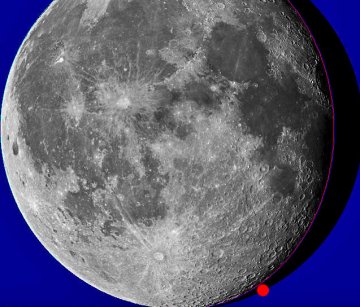 Click on the image for a more detailed view. Kaguya is a big spaceship. It masses 2,900 kg and will hit the Moon at an oblique angle traveling approximately 6,000 km/hr. Whether it tumbles and bounces along the lunar surface or runs headlong into some towering crater wall, no one can say. Clues to the end of Kaguya will come on June 10th in the form of an explosive flash (or lack thereof) and high-res images of the crash site taken by future lunar orbiters. The impact is not accidental. The Japanese space agency, JAXA, has long planned to end the mission in this fashion. Kaguya has been in lunar orbit since Oct. 2007; it has searched dark craters for evidence of frozen water, mapped the moon's gravitational field, and taken some of the all-time prettiest pictures of Earth's satellite. Farewell, Kaguya! Links for observers: #1: #2, #3. LUNAR IMPACT: Japan's Kaguya spacecraft crashed into the Moon on Wednesday, June 10th, and the impact reportedly produced a flash visible from Earth. This sequence of images comes from the 3.9 meter Anglo-Australian Telescope in New South Wales, Australia:Astronomers Jeremy Bailey and Steve Lee used the observatory's Infrared Imager and Spectrograph (IRIS2) to record the fireball, which appeared at 18:25 UT when the 2,900 kg spacecraft slammed into the lunar surface at 6000 km/hr. The observations were made with a 2.3 micron narrow band filter, and are part of a time series of 1 second exposures with 0.6 seconds dead time between each frame. Readers are asking, why bother hitting the Moon? For one thing, it's a good way to end a mission. Lunar satellites can't orbit forever because the Moon's gravitational field is weird and lumpy. Crashing is better than flying off into space, where the spacecraft could pose a hazard to other missions. Crashing also produces a fireball, which allows astronomers to estimate the "luminous efficiency" of objects hitting the Moon. Luminous efficiency is a key parameter required to interpret genuine lunar meteorite impacts. Also, hitting the Moon might uncover something interesting--like evidence of water. NASA's LCROSS spacecraft will attempt that trick later this year.
June 10, 2009 If there's one thing I've realized when writing articles about space, is that it is very easy to link a mysterious astronomical phenomena with doom. If not doom for Earth, certainly doom resulting in a huge explosion of some kind, destroying something, somewhere...
Mystery = Doom
Let's look at a very simple example: In 1983, NASA's Infrared Astronomical Satellite (IRAS) carried out the first ever space-based survey of the entire sky at infrared wavelengths. IRAS spotted some mystery infrared objects (make a note of the word "mystery"). This would be expected, I suppose, as this was the first survey of its kind. The Washington Post picked up on NASA's initial findings and published an article entitled "Mystery Heavenly Body Discovered," in which the author lays out some possibilities for these infrared objects. Initial reports postulated that one of these objects could be a long-period comet, or a planet, or a far-off young galaxy or a protostar. Innocent enough, you may think. However, this one news article planted the seed of an entire Planet X doomsday scenario that has given root to countless YouTube videos, doomsday books and now, a Sony Pictures movie, to be released in November. It's of little concern to doomsday "believers" that these mystery infrared objects were identified as ultra-luminous young galaxies far, far away, and not a nearby Earth-killing "Planet X". Doomsday theories stick, no matter how much evidence there is to the contrary. Shrinking Stars and Supernovae So, today I read about the incredible observation by astronomers that the famous red supergiant star Betelgeuse is shrinking. According to University of California, Berkeley astrophysicists, over the last 15 years, Betelgeuse has shriveled by 15% in diameter. This is a startling observation in my opinion. Although the star has undergone no variation in luminosity, to be able to distinguish a 15% reduction in size of a star some 600 light years away is astonishing. The supergiant isn't even an "easy" star to observe; as it's so old, it's undergoing some violent changes, blasting hot gas into space, shrouding its surface from view. Only by using the extremely sensitive Infrared Spatial Interferometer (ISI) on the top of Mt. Wilson in Southern California, researchers were able to see through the haze and measure the star diameter with such precision. On reading through the Berkeley press release, there is no mention that this shrinkage could indicate Betelgeuse is about to explode. Granted, the 15 year shrinkage is a "mystery" (there's that word again), but the star has been known to vary in size in the past. In fact, it is known to pulsate in size with periods of one and six years. Also, the rotational period of Betelgeuse is once every 18 years; simulations suggest the star is not spherical, so the shrinkage could be an illusion, we are seeing a potato-shaped disk on its thinnest edge. Despite all these factors, Fox News runs with the title "Nearby Star May Be Getting Ready to Explode." Using the Berkeley press release as a source, and quoting all the facts mentioned above, they've put two and two together, made five and declared stellar Armageddon. Oh dear. They've also made their own prediction right at the end:
Yes, it's totally possible Betelgeuse could explode, but the chances of this happening in this 600 year window is highly unlikely, regardless how fast it seems to be shrinking. Needless to say, the Fox article has done the best on the social bookmarking sites, hitting the front page of Digg. Everyone loves a supernova. As for the "shrinking star" reports, not so much. This may not have the makings of the next, great doomsday movie plot, but it is an example how definite conclusions (i.e. a supernova) can be made from a fairly benign, yet interesting astronomical "mystery". Sources: AFP, FOX, UCB, Universe Today
|
||||
| 6-9-09 - Sunspot 1021
Small, faint sunspot 1020 is a member of new Solar Cycle 24. Credit:
SOHO/MDI -calling this sunspot 12
speed: 313.4 km/sec density: 3.1 protons/cm3 explanation | more data Updated: Today at 2346 UT X-ray Solar Flares 6-hr max: A0 2340 UT Jun09 24-hr: A0 0620 UT Jun09 explanation | more data Updated: Today at: 2340 UT BIG ASTEROID FLYBY: Today, June 9th, asteroid 2003 QO104 is passing by Earth only 9 million miles away. Measuring 2 miles in diameter, the massive asteroid is about 1/3rd the size of the K-T impactor that probably wiped out the dinosaurs 65 million years ago. There's no danger of a collision this time, it's just a photo-op. flyby images: from Alberto Quijano Vodniza of Pasto, Nariño, Colombia
|
||||
| 6-8-09 - No sunspots today Current conditions
Solar wind
X-ray Solar Flares
TRANSIT OF VENUS: Five
years ago today, Venus made an
historic transit of the Sun. Our 15-page
photo gallery documents the crossing,
ranked by witnesses as one of the most
beautiful events of modern astronomy. The next
transit: June 6, 2012. Book your ticket for
the
South Pacific!
|
||||
| 6-7-09 - No sunspots today
Current conditions
Solar wind speed: 365.5 km/sec density: 2.1 protons/cm3 explanation | more data Updated: Today at 2323 UT X-ray Solar Flares 6-hr max: A0 2340 UT Jun07 24-hr: A0 1640 UT Jun07 explanation | more data Updated: Today at: 2340 UT ARIETID METEOR SHOWER: The annual Arietid meteor shower peaks on Sunday, June 7th. The Arietids are unusual because they are daytime meteors; the shower is most intense after sunrise. Early risers could spot a small number of earthgrazing Arietids during the dark hours before dawn on Sunday morning. After daybreak, you can listen to the shower by tuning into our online meteor radar.
|
||||
| 6-6-09 - No sunspots today
Solar wind speed: 306.9 km/sec density: 0.5 protons/cm3 explanation | more data Updated: Today at 2342 UT X-ray Solar Flares 6-hr max: A0 2340 UT Jun06 24-hr: B2 0325 UT Jun06 explanation | more data Updated: Today at: 2340 UT
|
||||
| 6-5-09 - Sunspot 1019 fading even more as it travels across the
face of the sun. Current conditions
Solar wind 6-hr max: A1 1910 UT Jun05 24-hr: A2 1320 UT Jun05 explanation | more data Updated: Today at: 2340 UT
|
||||
| 6-4-09 - Sunspot 1019 is in the center top of the sun but is
fading away - today they are calling it #17 Current conditions
Solar wind speed: 290.5 km/sec density: 1.1 protons/cm3 explanation | more data Updated: Today at 2344 UT X-ray Solar Flares 6-hr max: A0 1800 UT Jun04 24-hr: A4 1530 UT Jun04 explanation | more data Updated: Today at: 2340 UT |
||||
| 6-3-09 - Sunspot # 1019 - number 19 SUNSPOT 1019: New-cycle sunspot 1019 burst through the surface of the sun on May 31st and it has been growing rapidly ever since. This movie from the Solar and Heliospheric Observatory (SOHO) shows the progress of the active region over a two-day period:
more images: from Jérôme Grenier of Paris France; from Marco Vidovic of Stojnci, Slovenia; from Pavol Rapavy of Observatory Rimavska Sobota, Slovakia; from Steve Wainwright of Swansea, S.Wales, UK; from Gilles Frenette of Edmonton, Alberta, Canada; ; from Deirdre Kelleghan of Bray, Co Wicklow, Ireland; from J. Maciaszek and J. Stetson of South Portland, Maine; from Pete Lawrence of Selsey, West Sussex, UK; from Etienne Lecoq of Mesnil-Panneville, Normandy, France; from P-M Hedén of Vallentuna, Sweden; BLINDING FLASH: On May 31st, evening sky watchers in northern Poland were temporarily blinded by a sudden flash of light brighter than the full Moon. An automated camera in the town of Gniewowo captured this snapshot of the "un-night" sky:
Solar wind 6-hr max: A1 2155 UT Jun02 24-hr: B1 0640 UT Jun02 explanation | more data Updated: Today at: 2355 UT
|
||||
| 6-2-09 - sunspot #1019 - number 19 see photos above Current conditions Solar wind
X-ray Solar Flares Current Auroral Oval:
Switch to:
Europe,
USA,
New
Zealand,
Antarctica
|
||||
| 6-1-09 - sunspot 1019 coming around the corner of the sun - photos
above. it is called #11 on 6-1-09 and changed to #19 on 6-3-09 more images:
from Steve Rismiller of Milford, Ohio;
from Matthias Juergens of Gnevsdorf, Germany;
from Mike Borman of Evansville, Indiana;
from Peter Paice of Belfast, Northern Ireland;
from Cai-Uso Wohler of Bispingen, Germany;
from Howard Eskildsen of Ocala, Florida; speed: 309.3 km/sec density: 0.8 protons/cm3 explanation | more data Updated: Today at 2345 UT X-ray Solar Flares 6-hr max: A9 1855 UT Jun01 24-hr: A9 1855 UT Jun01 explanation | more data Updated: Today at: 2340 UT SOLAR ACTIVITY: "Solar activity is heating up!" reports Robert Arnold from the Isle of Skye, Scotland. This morning he photographed a fiery prominence and a new sunspot emerging near the sun's northeastern limb:
DREAMS OF THE GREAT EARTHCHANGES - MAIN INDEX
|
||||




